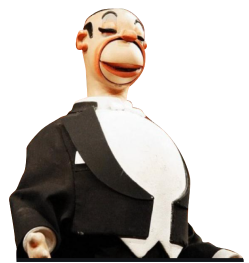Theatre History
The 1930s
In May 1930, the All-Russian Puppet Theater Workers Conference in Moscow was attended by the country's best puppeteers. It was decided to create the Central Puppet Theater as an «experimental laboratory of the puppet genre» there. Sergey Obraztsov, a young, talented actor of the «original genre», was invited to become the head of the theater. Thus, on September 16, 1931, at the Central House of Art Education of Children, a puppet theater was opened. Later it became the largest puppet theater in the world. At first, the theater did not have its own stage - only a small room for rehearsals. Performances had to be shown in schools, clubs, parks, hospitals or even in courtyards. Therefore, the theater spent the first year travelling. At first the troupe of 12 people and the scenery moved around Moscow on a cart harnessed with a gelding named Kater, later - on a painted van. Despite this, the success of the first performances — «Jim and the Dollar» (1932), «Puzan» (1934), «Chestnut» (1935), and «Gosling» (1935) — was huge. That is when the play «By the Pike's Command» appeared in the repertoire. This performance became the hallmark of the theater. Obraztsov called the play «our Seagull» (by analogy with the famous performance of Moscow Art Theater). Theater critics compared it with Meyerhold's productions and considered it as one of the puppet discoveries of the 20th century. By the Pike's Command (1936) is still a part of the theater's repertoire and it is still loved by the audience. The success of the young troupe was noticed and a venue on Mayakovsky Square was allocated to the the theater in 1936. The first performance called «Puss in Boots» took place on the new stage on October 3, 1937. In the same year, the Museum of Theater Puppets and a library were opened at the State Central Theater Complex.
The 1940s
The troupe expanded, and Obraztsov continued to experiment and to destroy stereotypes. The premiere of «Aladdin's Magic Lamp» in 1940 was a big event. The performance was intended not for young, but for adult spectators. Besides, reed puppets were used for the first time in the play. Thanks to the changes proposed by artist Boris Tuzlukov, the puppet movements became more graceful and expressive. Over time, the «target audience» of the performance has grown younger, and today the story of Aladdin captivates little viewers with its oriental charm.
During the Great Patriotic War, the theater organized 16 concert brigades, which gave 328 performances at the front line. By doing so, the concert brigades were raising the spirit of the soldiers. Special front-line programs were prepared. Programs such as «Hitler's Dream», «Over the Roof of Berlin» were made out of parody sketches on political topics. Theater actors performed for both children and adults in the cities of the Volga region, Altai, Siberia, Kazakhstan.
«Extraordinary Concert» is by far the most famous puppet show not only at the Obraztsov Theater, but all over the world. It is listed in the Guinness Book of Records as the show that was watched by the largest number of viewers around the world. There is an interesting story associated with its creation. The play, made up of funny parodies of multiple techniques and clichés of popular concerts and performers, was first called «An Ordinary Concert». The premiere in 1946 was a huge success. However, three years later the performance was banned, accused of denigrating Soviet artists. To think only - not even a single positive hero there! Is this what ordinary concerts in the USSR look like? In order to save the performance, Obraztsov removed several particularly daring parts and changed its name to «Concert of Puppets». He even personally performed in it as a presenter for a while. This meant that everything shown on stage was just fiction. Problems with censorship were resolved, and the performance began its triumphal march around the world. In 1948, the theater began touring around the world. It has visited many countries in Europe, Asia and America since.
The 1950s
Since 1956, the Obraztsov Theater has been a regular participant in international puppet festivals held under the auspices of UNIMA. Being under influence of the Obraztsov Theater tours, state puppet theaters were established in a number of countries - Poland, Bulgaria, Hungary, the Czech Republic ...
The 1960s
From its first performance «Jim and Dollar» (1932) and until the early 70s, when the Obraztsov Theater became «academic», it was the very experimental laboratory for which it was created. Since the very first years of the Theater creation Obraztsov gathered an incredible constellation of talented people: actors, artists, directors. Such directors as Shvemberger and Gromov, Ablynin and Hait, Stein and Feinstein created within Obraztsov Theatre. Each of them created their own puppet theatre. For instance, the student of E. Vakhtangov, Viktor Shvemberger is the founder of four wonderful professional puppet theaters - Children's Book Theater (Moscow Puppet Theater), Chernigov (Ukraine), Kyrgyz State (Bishkek) and Moscow Regional Puppet Theater.
For many years Lenora Shpet was Obraztsov's associate. The «godmother of the Theater», not only was she the head of the literary part of the theater, but later - she also became one of the creators of the cabinet of children's theatres and puppet theatres under the WTO, as well as the Soviet section of the International Union of Puppet Theatre UNIMA. Among Obraztsov's students there is an actor, director, playwright Eugene Speransky («Under the rustle of your eyelashes», «I-Go-Go», «Krasa Naglyadnaya», «Kashtanka», «Soldier and Witch» (based on H. C. Andersen) and others); actor and director Semyon Samodur; actor Zinovy Gerdt and many others. The names of artists Boris Tuzlukov (the first performance with rod puppets for adults «The Magic Lamp of Aladdin» 1940, «Divine Comedy»1961), Valentina Andriyevich («Extraordinary Concert» 1946, «Under the rustle of your eyelashes» 1949, «Buratino” 1953), Alina Speshneva («Don Juan» 1975, «Three Fat Man» 1977, «Cunning Hedgehog» 1979), Marina Sokolova («The Tale of Tsar Saltan” 1974, «Dragon» 1980, «38 parrots» 1982) could be seen on the Theater's show bills.
The 1970s
A new era of the Obraztsov Theater began in 1970. The theater moved to Sadovaya-Samotyochnaya Street, where it is still located. This move was vital for the theater - the building on Mayakovka was sorely lacking space. Whereas, in the new building, everything was made to create a magical puppet world - a complex sliding curtain, transforming walls of the hall and, of course, a magnificent clock on the facade. This clock became a symbol of the theater. You do not have to go inside the building if you want to see the puppet show of the Obraztsov Theater. Just go to the clock at noon (or midnight) and watch its magical life. All twelve houses on the clock face open and fairy-tale characters greet the audience to the music of Nikita Bogoslovsky. One window opens every hour. The idea belongs to Sergei Obraztsov. The watch authors are sculptors Dmitry Shakhovskoy and Pavel Shimes, the mechanism was invented by Veniamin Kalmanson.
In 1976, the XII Congress of the International Union of Puppet Theatre Workers - UNIMA was held for the first time in Moscow. The largest international festival of puppet theaters in the USSR was held at the same time.
The 1990s
Sergei Vladimirovich Obraztsov passed away in 1992. Obraztsov Theater experienced difficult time of searching. In 1994, following the traditions of the Theater, Obraztsov's student and associate Vladimir Kusov staged the play "Hercules", which is based on the play by Mikhail Bartenev. In the same year, a famous screenwriter and director Rezo Gabriadze, the founder of the Tbilisi Puppet Theater, was invited to Obraztsov theater to become its artistic director. However, the director and the team failed to form a creative alliance.
In 1998, Estonian puppet theatre director Rein Agur and production designer Elena Lutsenko staged Shakespeare's play «The Comedy of Errors» at Obraztsov Theatre.
In 1996, Ekaterina Obraztsova, the granddaughter of Sergei Obraztsov, was invited to the theater as a stage director. Ekaterina Obraztsova, actress and director, Honored Artist of the Russian Federation, formed a creative tandem with Sergei Alimov, People's Artist of the Russian Federation. This tandem developed during their first joint production at the Theater «The Queen of Spades» (1999), based on the novel of the same name by Pushkin.
The 2000s
In 2000, a young talented actor and director Andrei Dennikov came to the Obraztsov Theater. While working at Theatre, The Honored Artist of the Russian Federation Dennikov staged 12 performances in the genre of synthetic theater. Synthetic theater is when the performance of tabletop puppets is combined with singing, dancing and acting.
The 2010s
Between 1999 and 2019, director Ekaterina Obraztsova and artist Sergei Alimov staged nine performances on Large and Small stages. Five of them can be seen nowadays: Gulliver's Travels (2008) based on Swift's satirical fantasy novel; The Night Before Christmas (2004) based on Gogol's phantasmagoric story; Three Little Pigs (2015) based on the famous fairy tale in Mikhalkov's edition; Baron Munchausen (2018) based on the book of stories about the adventures of the famous storyteller; «Don Quixote» (2016) based on the immortal novel by Cervantes.
In 2013 Boris Konstantinov, one of the most outstanding directors of Russian puppet theatre, became the chief director of the Obraztsov Theater. Honored Artist of the Russian Federation, laureate of the Russian National Theater Prize «Golden Mask». A wordless performance «Thumbelina» (2008) was his first production at the Theater. In 2011 he staged a chamber play «Snowman» based on Andersen's fairy tale. This performance was a Laureate of the Russian National Theater Prize «Golden Mask» for «the best work of a puppet theater actor» and «the best work of an artist in a puppet theater». In 2013 he released a musical and poetic performance «A puppy walked down the street" on the Big stage. This play is based on the poems of modern children's poets Vadim Levin and Renata Mukha. It was a participant of a special program of the Golden Mask festival «Children's weekend». In his production of «Ali Baba and the Forty Thieves (2014)» Konstantinov creatively revealed the traditions of the Uzbek folk puppet theater. He embodied the classic comedy by Beaumarchais «The Crazy Day or The Marriage of Figaro» (2014) by combining puppets and actors performing. In July 2014, the master class of the famous French puppeteer, director and actor Nicolas Gusseff «Sound Painting - Improvisation Technique» was actively used to work with the cast of the play on the implementation of the director's ideas for the production of The Marriage of Figaro. The master class came with the support of the French Institute in Russia.
In 2015, the play was nominated for the National Theatre Award «Golden Mask” in the categories «Best Performance of Puppet Theatre», «Best Director's Work», «Best Artist's Work». The performance received Moskovskiy Komsomolets newspaper award as the best puppet theater performance.
The previously staged blockade fairy tale «Leningradka» (2015) was transferred to the Small Stage of the Obraztsov Theater. Later, large-scale productions of famous fairy tales were performed on the Big Stage - «Scarlet Flower» (2015) by Aksakov; «Turandot» by Gozzi (2017), which received six nominations on «Golden Mask 2019»; «Tale of Tsar Saltan» by Pushkin(2019). In 2018, a play based on Vasily Shukshin's dramatic story «A Wife got her Husband to Paris» was performed on the Third Stage. Andersen's «Ugly Duckling» premiered in 2020.
Nowadays
Today the Obraztsov Theater is a place where the traditions laid down by Sergei Obraztsov and modern trends in puppet theater are harmoniously combined. This theater is a place where people and puppets live and work together. And together they tell some really amazing stories every day. You are welcome to come to the Theater and feel the magic of puppets!






